Oct. 22 update on COVID-19 in MN: Deaths jump again; hospitalizations climbing
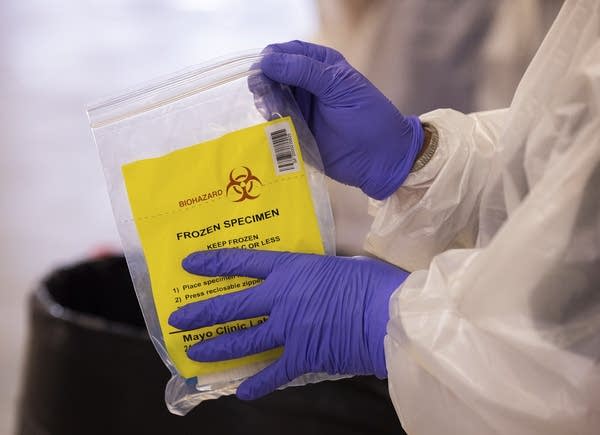
Go Deeper.
Create an account or log in to save stories.
Like this?
Thanks for liking this story! We have added it to a list of your favorite stories.
Updated 12 p.m.
Minnesota’s COVID-19 death toll continues to climb steeply. The Health Department on Thursday reported 20 more deaths atop 35 deaths the prior day, the largest two-day rise since late May.
Nearly 1,600 newly reported cases of the disease continued an October that’s seen counts averaging more than 1,000 a day. The trend of active confirmed cases of the disease remains at a record high.
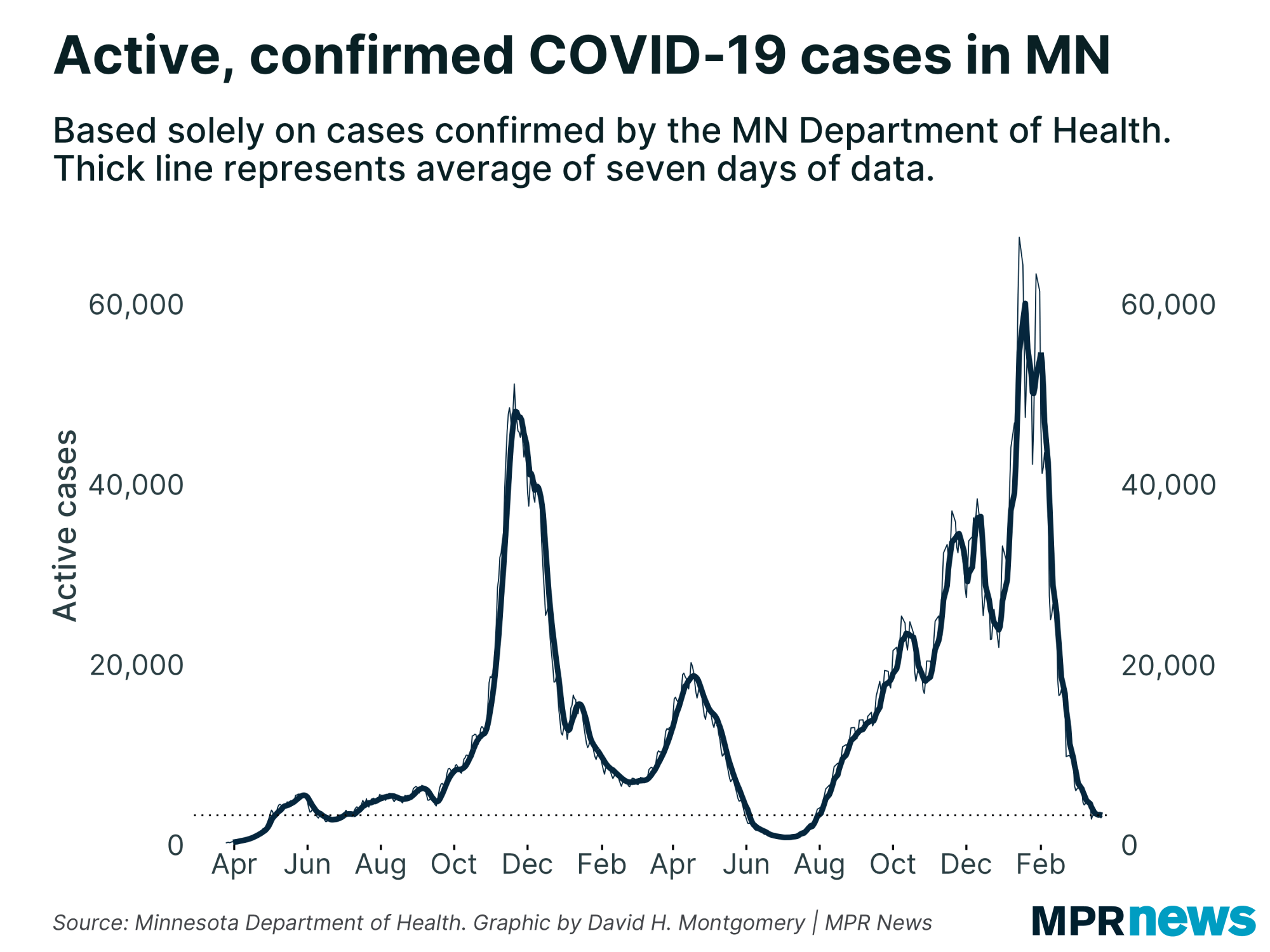
Hospitalizations continue to climb. Minnesota’s seven-day trend of newly reported hospital admissions hit a second consecutive record high, now averaging 82 a day over the last week.
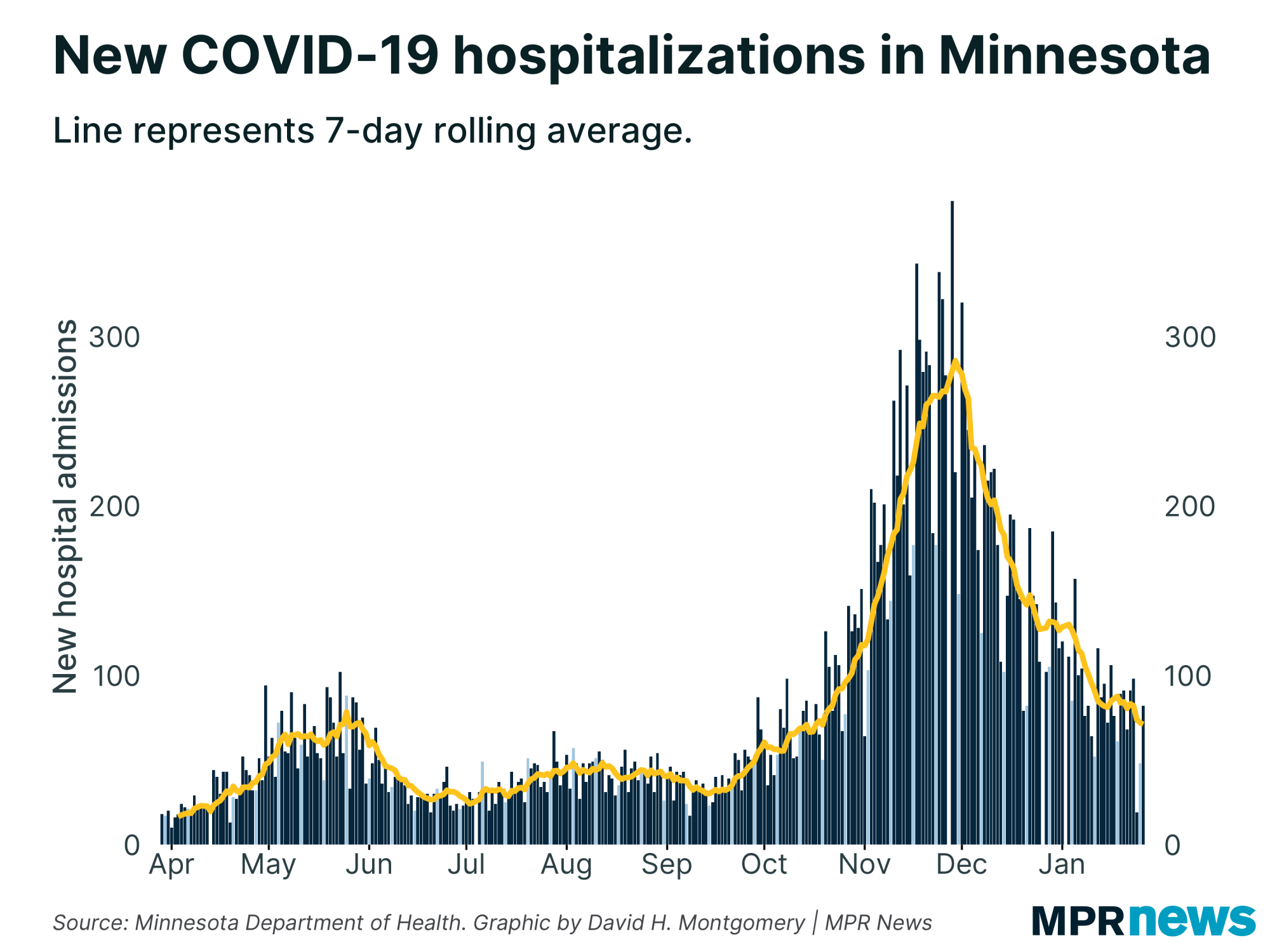
State officials expected that late summer and early fall gatherings, sporting events and informal meetups among Minnesotans would deliver a surge of cases in October. They also anticipated the wave would put more people in the hospital — and lead to more deaths.
Minnesota Health Commissioner Jan Malcolm on Wednesday called the recent data sad but not surprising, and she warned Minnesota to brace itself for more cases, hospitalizations and deaths unless more people take personal responsibility to stem the disease’s spread.
Turn Up Your Support
MPR News helps you turn down the noise and build shared understanding. Turn up your support for this public resource and keep trusted journalism accessible to all.
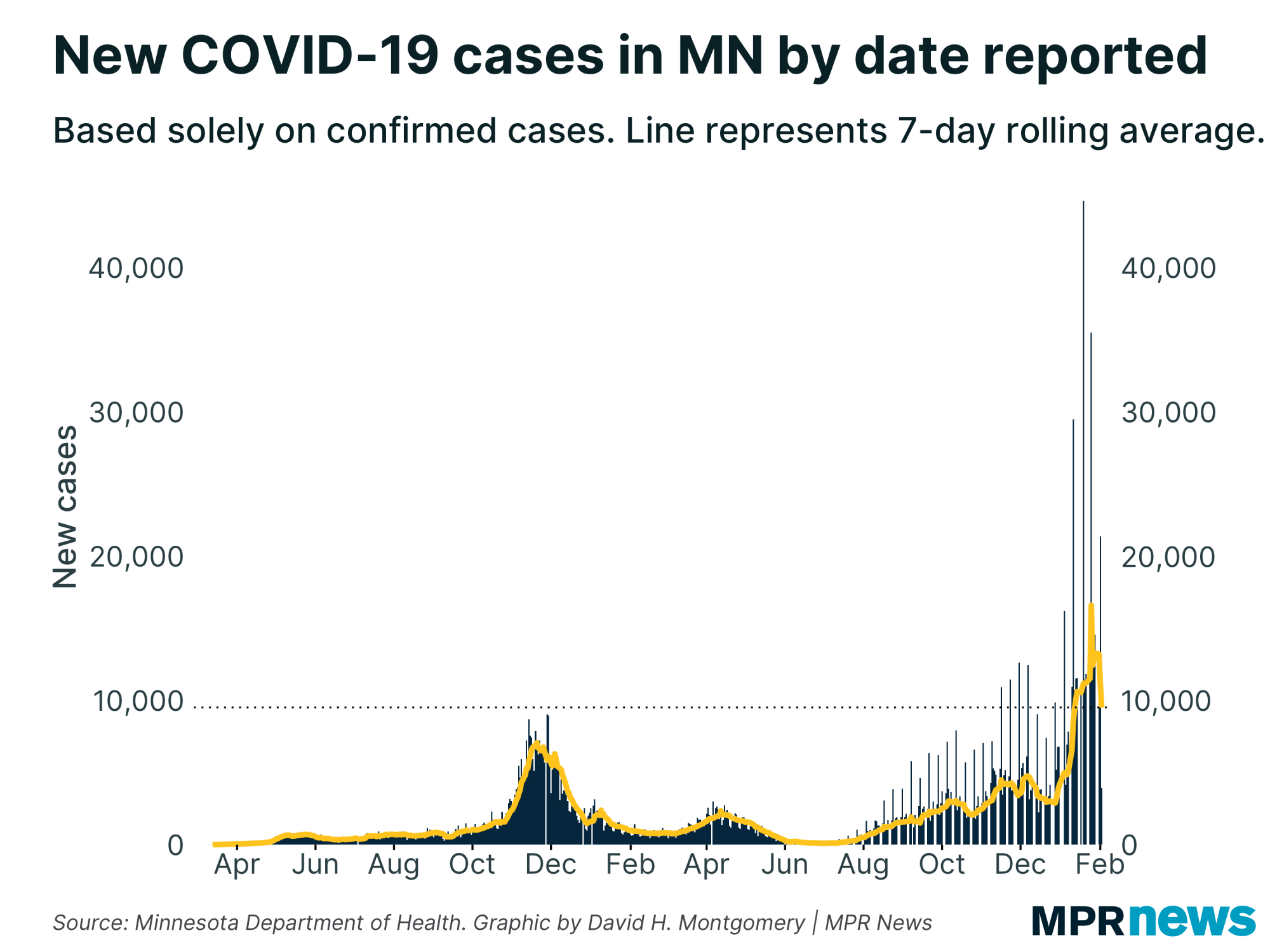
Health authorities remain concerned that Minnesotans, fatigued by more than seven months of trying to stay vigilant against the virus, are letting their guard down in private settings, even as the virus spreads.
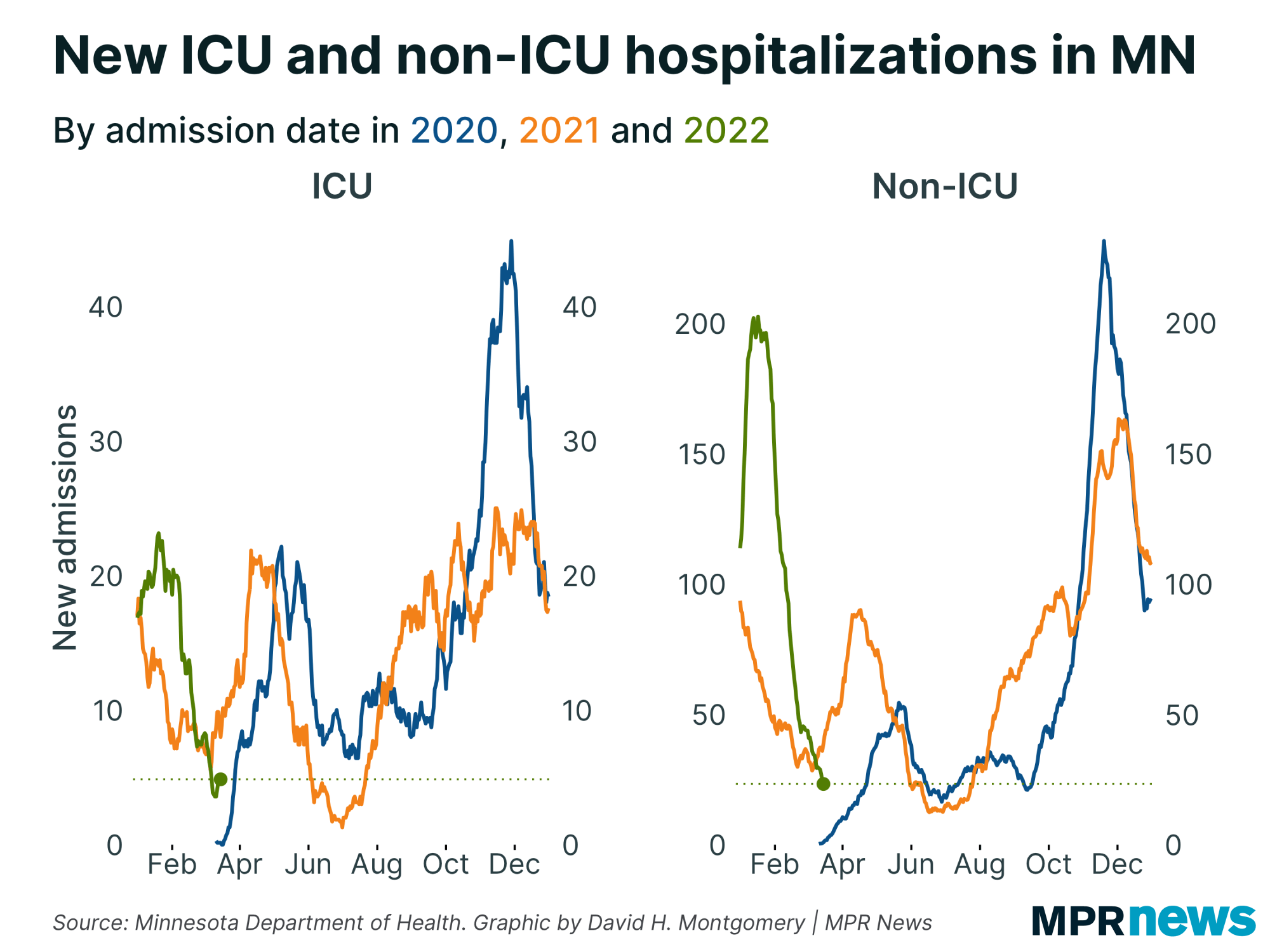
“We do need to understand that more cases are going to lead to more people with serious disease, potentially with long-term complications we are only beginning to understand,” Malcolm said.

The 20 newly reported deaths raised Minnesota’s toll to 2,301. Among those who’ve died, about 70 percent had been living in long-term care or assisted living facilities; most had underlying health problems.
New cases reported Thursday brought the total in the pandemic to 128,152 to date; about 89 percent have recovered to the point they no longer need to be isolated.
Caseloads rising across age groups
New cases are up dramatically over the past month in all age groups. That includes a concerning rise in the number of new cases among Minnesotans ages 60 and older.
People in their 20s still make up the age bracket with the state’s largest number of confirmed cases — more than 28,000 since the pandemic began, including more than 16,000 among people ages 20-24.
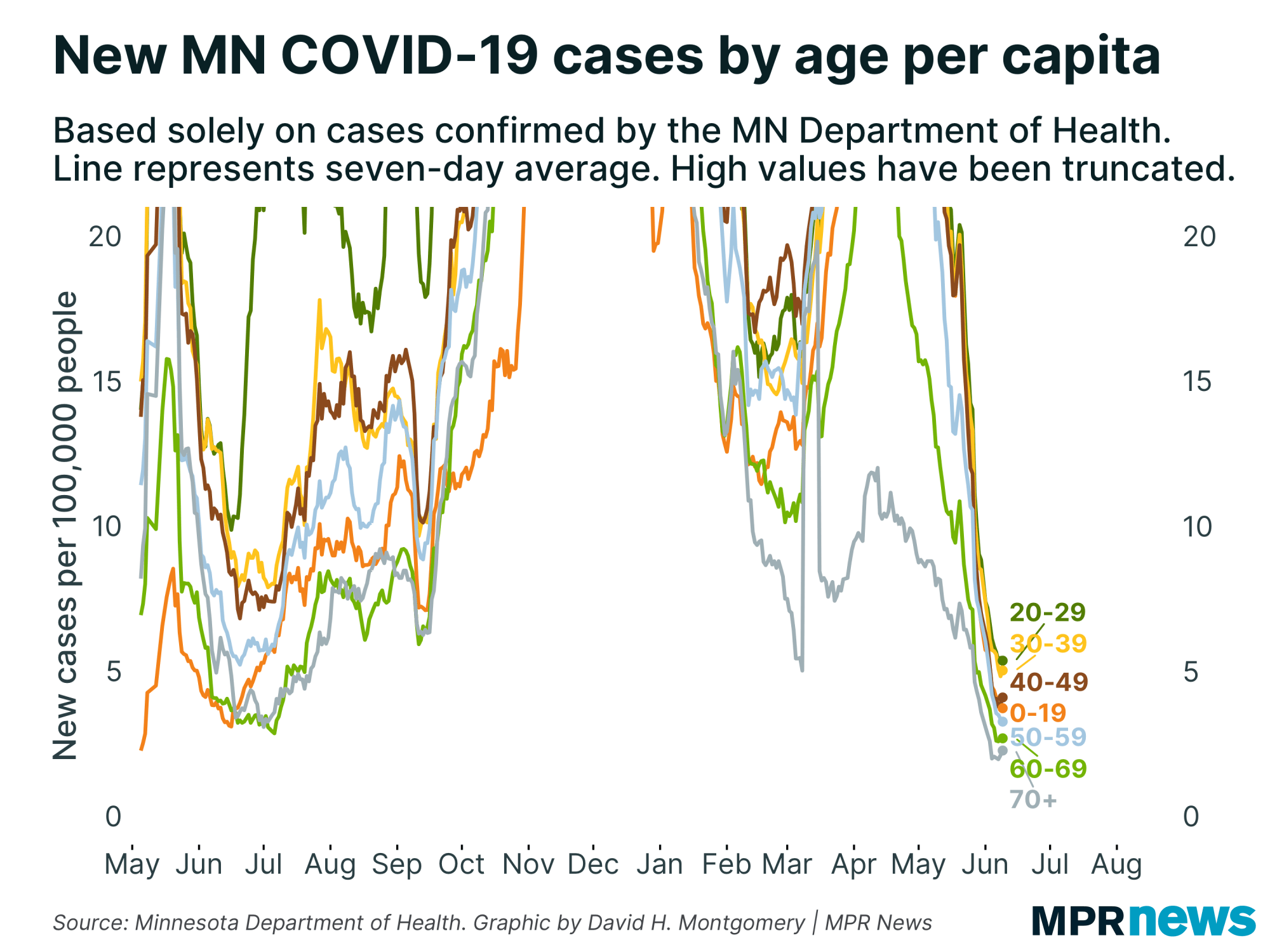
The numbers help explain why experts remain particularly concerned about young adults as spreaders of the virus.
While less likely to feel the worst effects of the disease and end up hospitalized, experts worry youth and young adults will spread it to grandparents and other vulnerable populations and that spread could hamper attempts to reopen schools and campuses completely to in-person teaching.
The number of high school-age children confirmed with the disease has also grown, with more than 11,500 total cases among children ages 15 to 19 since the pandemic began.
Cases surging along Minnesota’s western border
Regionally, central, northern and southern Minnesota have driven much of the recent increase in new cases while Hennepin and Ramsey counties show some of the slowest case growth in the state.
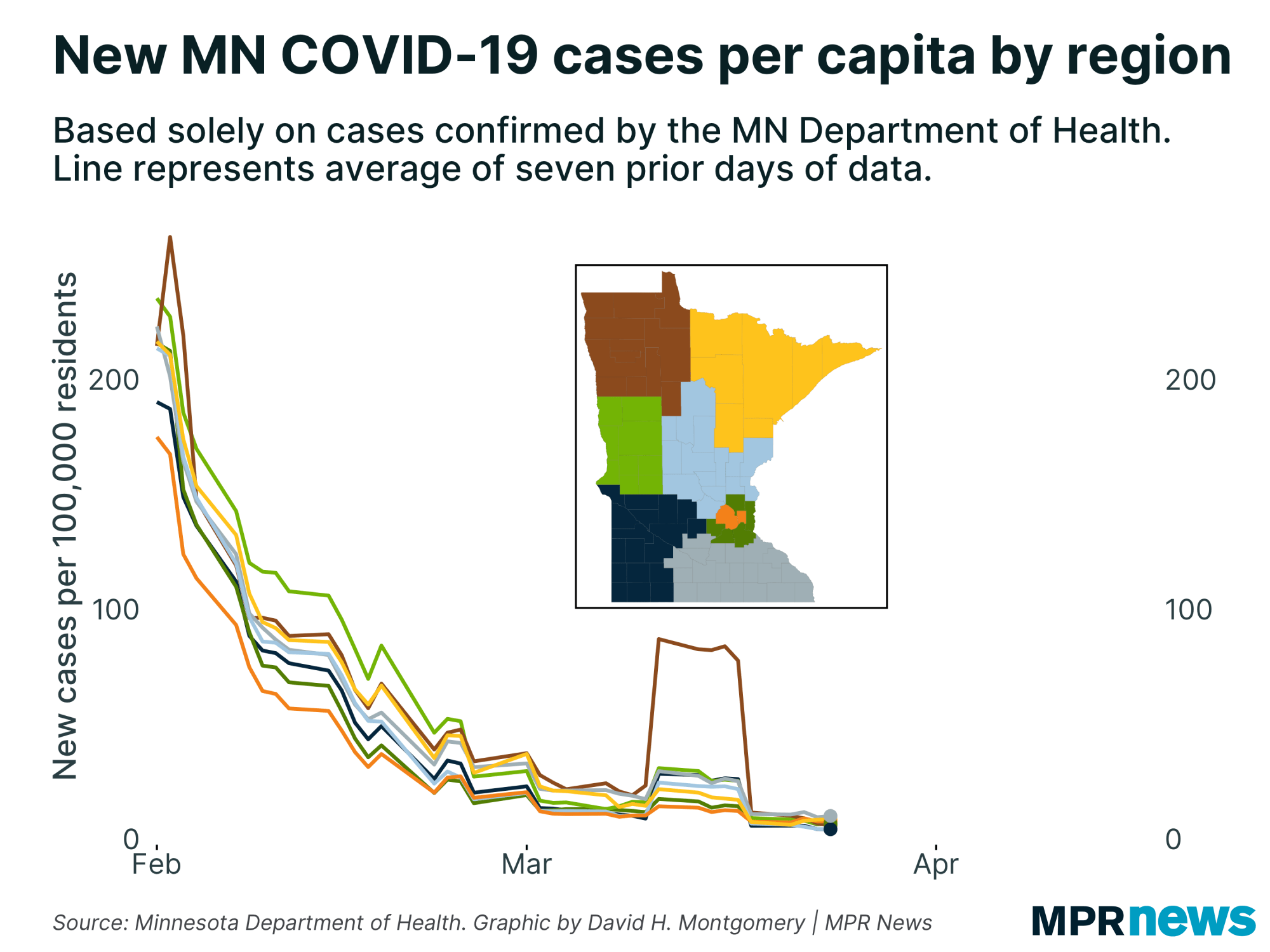
Newly reported cases are highest in western Minnesota — the northwest, west-central and southwest areas of the state have been averaging more than 40 new cases per day per 100,000 people, higher than any of the state’s central and eastern regions.
The data don’t explain why. However, cases are surging currently in the Dakotas. North Dakota has the country’s worst per-capita spread rate.
Collectively, rural areas of Minnesota continue to report the most new COVID-19 cases.
Northern Minnesota, once the region least affected by the disease, has also seen its caseload grow dramatically in recent weeks. Deaths are also spiking in northern and central Minnesota.
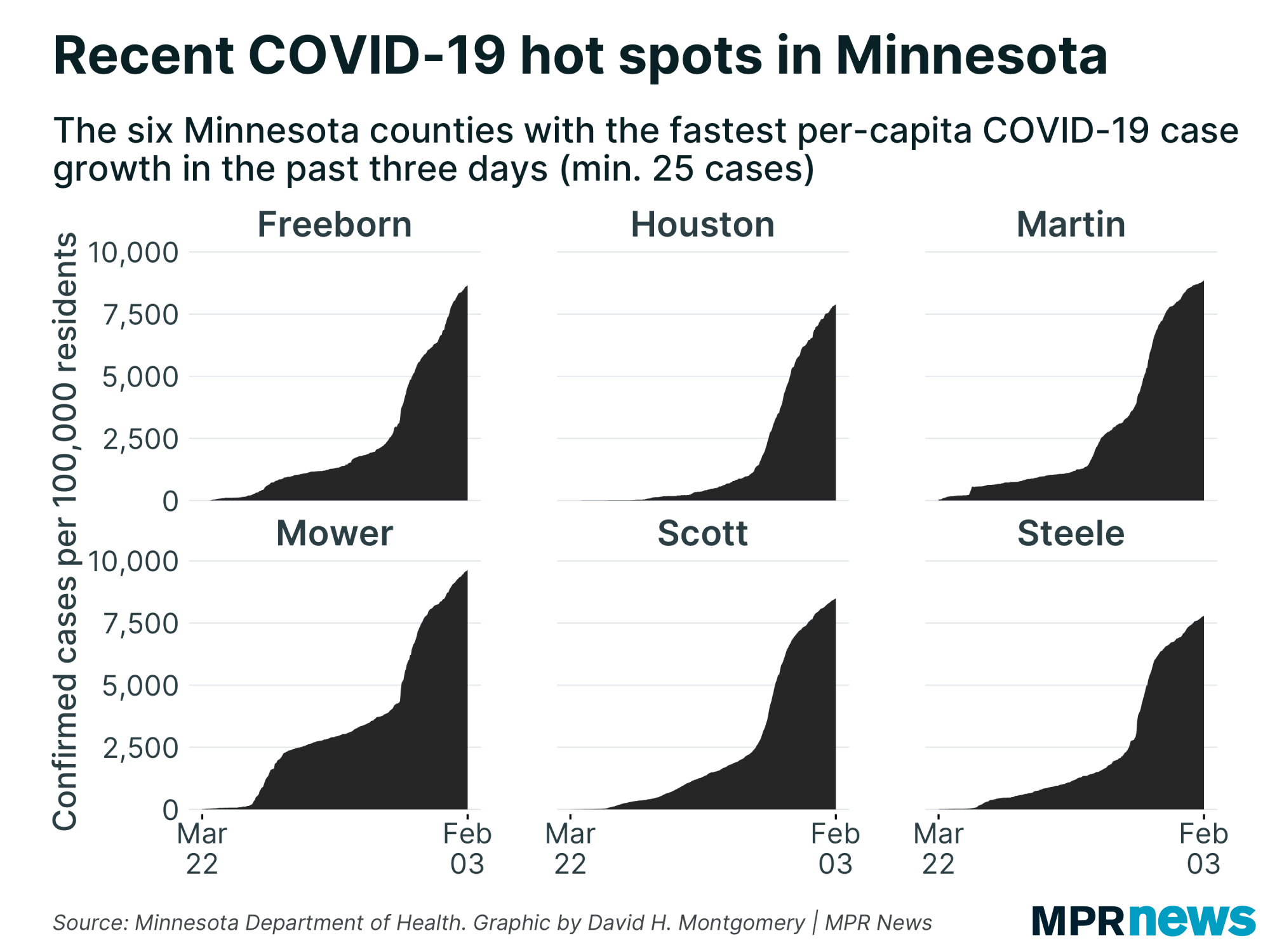
“We are seeing more deaths in greater Minnesota because we are seeing more cases there,” Kris Ehresmann, the state’s infectious disease director, said Wednesday. “We will see more and more deaths from greater Minnesota because of the high caseload.”
Ehresmann and Malcolm tied the recent steep rise in cases and deaths to “COVID fatigue” but also described people who are ill but refuse to get tested because they don't want to admit they have it and don't quarantine as a contributing factor in spreading the disease.
Latino, Indigenous cases jump
In Minnesota and across the country, COVID-19 has hit communities of color disproportionately hard in both cases and deaths.
Minnesotans of Hispanic descent are testing positive for COVID-19 at about five times the rate of white Minnesotans. They, along with Black Minnesotans, are also being hospitalized and moved to intensive care units at higher rates than the overall population.
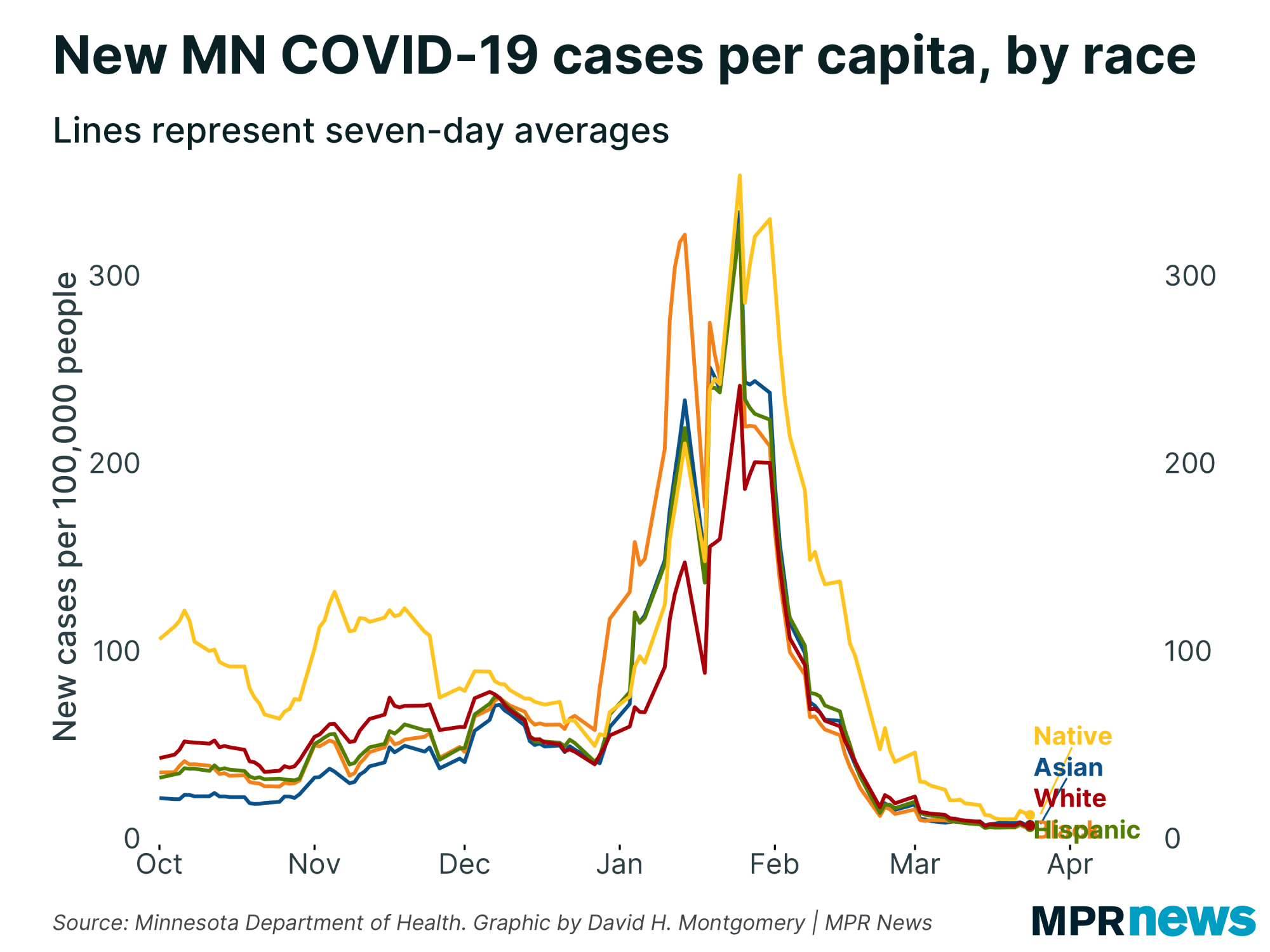
Similar trends hold true for Minnesota’s Indigenous residents. Counts among Indigenous people have jumped in October relative to population.
Data the past two weeks also show newly confirmed cases continuing to accelerate among Latino people in Minnesota.
Distrust of the government, together with deeply rooted health and economic disparities, have hampered efforts to boost testing among communities of color, particularly for unauthorized immigrants who fear their personal information may be used to deport them.
‘We need to take this seriously’
The newest numbers came after Minnesota officials, seeing rampant spread across the state, strongly suggested people rethink their holiday plans and avoid multifamily celebrations or big gatherings with friends.
Traditional year-end holiday gatherings may simply may be too risky in a pandemic, Malcolm said Monday.
“The transmission is everywhere, not just one or two sources or one or two kinds of settings. It’s the individual decisions that we’re all making fueling the rate of increase we’re seeing,” Malcolm cautioned. “We need to take this seriously.”
While surges early in the pandemic were driven largely by illnesses tied to long-term care facilities and workplace sites such as meatpacking plants, officials say the current spread is diffused, making it even harder to trace and isolate cases.
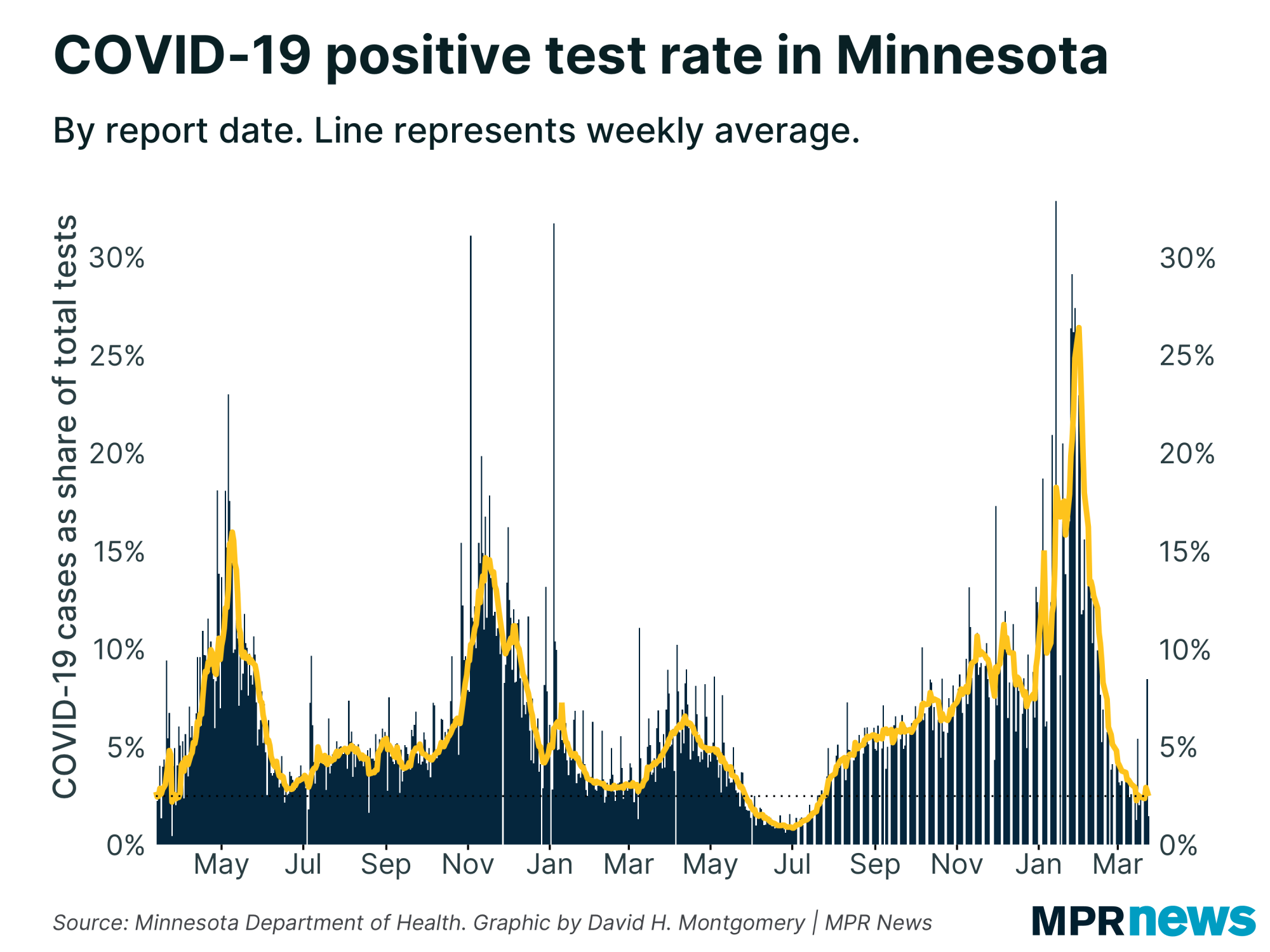
“Going out for happy hour after work with your coworkers or getting together with a bunch of friends that you haven't seen for awhile, all of that seems pretty innocuous. But in reality all of those different interactions can lead to transmission,” Ehresmann told MPR News on Monday.
Later Monday, Ehresmann said Minnesotans should think about holiday gatherings of 10 or fewer this year instead of big potluck dinners across multiple families.
On Wednesday, she and Malcolm again implored Minnesotans to take personal responsibility to stem the spread of the disease, including wearing masks in indoor public spaces, socially distancing and staying home if you feel ill.
“It’s hard,” said Malcolm, “but it’s not complicated.”
Developments around the state
COVID closes Cottonwood Co. recorder’s office
In southwestern Minnesota, Cottonwood County officials on Thursday said they are closing the county recorder’s office at least until Nov. 4 due to employee exposures to a positive COVID-19 case.
State and local health officials are currently contacting people who might have been affected, the county said in a statement.
— MPR News Staff
MN launches in-home COVID-19 saliva testing program
The Minnesota Department of Health on Thursday launched an at-home saliva testing pilot program in two dozen counties or tribal nations around the state. Most locations have few testing options and many are in greater Minnesota, where spread of the virus has been rapid in recent weeks.
The state has contracted with Vault Health to provide the saliva tests, which have been rolled out at in-person collection sites around the state.
People in these counties will be able to order the same test through the mail. It will be shipped to their home and performed with the help of a health care professional over the internet. The test will then be shipped to a facility in Oakdale, and results will be available electronically in 24-48 hours.
Test-takers will be asked for insurance information, but it will be free if insurance won't cover it or if they don't have insurance.
— Catharine Richert | MPR News
Winter Carnival organizers say show will go on, with changes
Organizers of the St. Paul Winter Carnival say the annual celebration will go on next year, but with changes because of the pandemic.
The ice- and snow-carving events will move to drive-thru displays at the state fairgrounds, the St. Paul Heritage and Festival Foundation said. A 5K race around Lake Phalen will replace the usual runs out of downtown St. Paul. The two traditional parades have already been canceled.
Organizers say they are bringing back a softball tournament and moving the long-running jigsaw puzzle contest online via Zoom teleconferencing.
The Winter Carnival is scheduled for Jan. 28 through Feb. 7.
— Tim Nelson | MPR News
DFL state senator tests positive
A DFL state senator is in the quarantine phase after testing positive for COVID-19.
Sen. Dan Sparks of Austin said he test he took Oct. 8 came back positive. He sought the test after experiencing flu-like symptoms a few days earlier.
Sparks didn’t come to the Capitol for the recent special session and says he’s been doing his work remotely. A few other lawmakers have disclosed their own bouts with the virus since this spring.
— Brian Bakst | MPR News
Top headlines
Hotel stays help dozens experiencing homelessness find more permanent homes: Hennepin County moved people, especially those most vulnerable to the worst effects of COVID-19, from shelters into private rooms in five hotels. The plan was to reduce crowding and protect people most at risk. There was another benefit: 56 people have moved into permanent housing since the start of the hotel efforts.
Wisconsin's Country USA and Rock USA festivals call it quits: Two of Wisconsin's biggest annual music festivals are shutting down for good following coronavirus-related cancellations this summer.
First-year teachers get a crash course on dealing with chaos and change in pandemic: Managing classroom chaos — and anxiety — are just some of the usual challenges that come with being a first-year teacher. But this year, those new teachers also have to master remote learning and managing all of the extra health protocols.
COVID-19 in Minnesota
Data in these graphs are based on the Minnesota Department of Health's cumulative totals released at 11 a.m. daily. You can find more detailed statistics on COVID-19 at the Health Department website.


